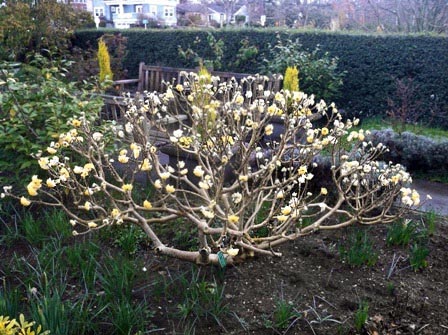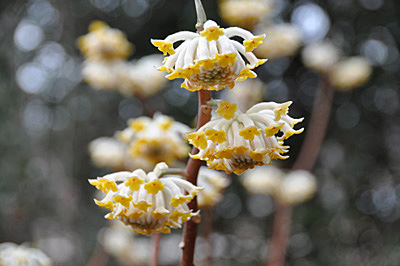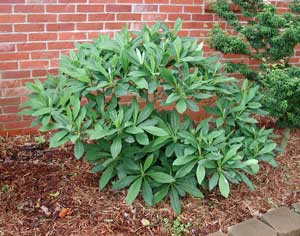Edgeworthia: A Plant Worthy of Its Name
By Gretchen Spencer, Fairfax Master Gardener
One of the many joys of gardening is discovering a new plant — especially one with unusual and intriguing attributes. For me, encountering the paper bush (Edgeworthia chrysantha) was one of those joyful discoveries. I first spotted it last summer on a walk in my neighborhood; its lovely, rounded shape; handsome blue-green leaves; and cinnamon-colored, speckled bark caught my eye, though I didn’t know what it was. The homeowner didn’t know either, having received it as a gift years ago. A plant mystery was born!

Edgeworthia in bloom
Edgeworthia chrysantha was named for Michael Pakenham Edgeworth (1812-1881), an Irish botanist who served in the Indian Civil Service. While traveling extensively in India, he collected many new plants. A native of China and the Himalayas, edgeworthia is also known as paper bush or rice paper plant there, as its bark was used to make paper. Chrysantha refers to the shrub’s yellow flowers. It is a member of the Thymelaeaceae family and a cousin of Daphne odora, also a sweet-smelling, winter-blooming shrub that prefers shade.

Edgeworthia flowers have the appearance of umbrellas
Edgeworthia comes into its own in the winter. It’s then that the white, drooping buds on the tips of bare, reddish branches stand out in the garden. In late February, the buds swell and open to reveal many small, tubular flowers with yellow centers.
The flowers hang down like tiny umbrellas and perfume the air with a lovely scent, foreshadowing spring. The flowering takes place from early February to April before the new leaves emerge.

Edgeworthia in summer
Edgeworthia’s handsome leaves, compact shape, showy bark, and lovely fragrant flowers make it a desirable plant for shady areas of the garden. It is truly a worthy shrub to cultivate and admire throughout the seasons.
References
Edgeworthia chrysantha, Dirr’s Encyclopedia of Trees and Shrubs, by Michael A. Dirr, 2011
Paper Bush Plant, Edgeworthia chrysantha, Monrovia Plant Catalog
Paper Bush (Edgeworthia chrysantha): A Shrub for Winter Color and Fragrance, Cornelius Tarver, Cobb County (Ga.) Cooperative Extension
Edgeworthia chrysantha, Missouri Botanical Garden